什么是Emma
EMMA 是一个开源、面向 Java 程序测试覆盖率收集和报告工具。
它通过对编译后的 Java 字节码文件进行插装,在测试执行过程中收集覆盖率信息,并通过支持多种报表格式对覆盖率结果进行展示。 EMMA 所使用的字节码插装不仅保证 EMMA 不会给源代码带来“脏代码”,还确保 EMMA 摆脱了源代码的束缚,这一特点使 EMMA 应用于功能测试成为了可能。
如何使用
emma现在可以通过命令行,ant,maven,Jenkins等方式使用,这里只介绍通过maven和Jenkins来集成emma测试。
在Maven中的使用
直接运行mvn emma:emma,即可。
maven集成emma,需要两个插件,maven-surefire-plugin和emma-maven-plugin,如果之前没有安装,那么maven会自动下载这两个插件。
emma依赖于surefire的配置,默认执行src/test/java的junit测试。为了方便使用,最好在自己的pom里配置maven-surefire-plugin插件。
<plugin><groupId>org.apache.maven.plugins</groupId><artifactId>maven-surefire-plugin</artifactId><version>2.8.1</version><configuration><skipTests>false</skipTests><junitArtifactName>junit:junit</junitArtifactName><includes><include>**/*Test.java</include></includes><excludes><exclude>**/*_Roo_*</exclude></excludes></configuration>
</plugin>
这样指定 maven-surefire-plugin 的版本为2.8.1,<skipTests>false</skipTests>不跳过测试,<include>**/*Test.java</include> 只测试以 Test.java 为文件名结尾的文件,而且不测试<exclude>**/*_Roo_*</exclude> 文件名包含_Roo_的文件。
更多的配置可以去查看maven-surefire-plugin的配置说明
- http://maven.apache.org/plugins/maven-surefire-plugin/。
在Jenkins中的使用
在Jenkins系统管理的插件管理页面,添加Jenkins Emma plugin插件。
在项目配置中,加入emma:emma即可使用。

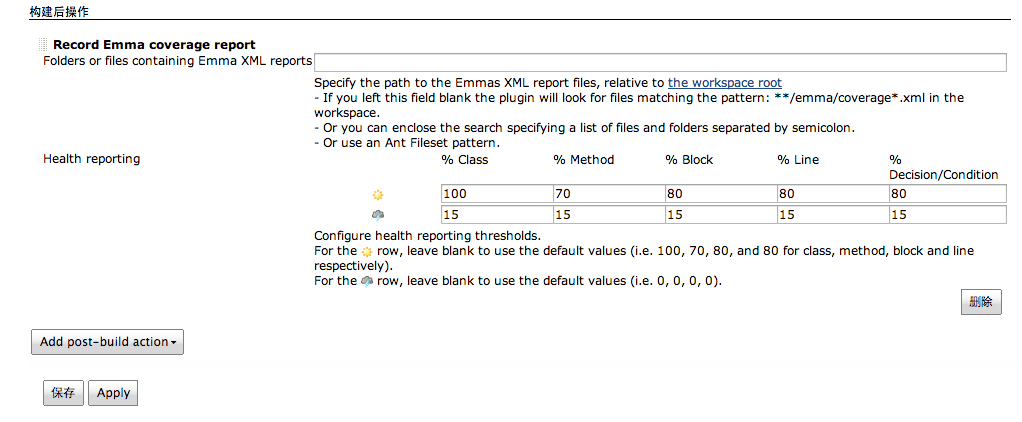
因为测试需要很长时间,而package命令会自动执行测试,所以有时候我们不想所有项目都测试。可以使用如下方案:系统配置两个分支,A分支用于开发,B分支用于上线。我们希望只要A分支进行emma测试,而在B分支不用测试方便快速上线。配置如下
在项目的pom.xml中,<skipTests>false</skipTests>默认不跳过测试,在B项目中配置 clean -U compile package -Dmaven.test.skip=true ,用来跳过测试。
查看测试报告
本地测试查看:
生成的报告是以html存储,默认的位置是${项目目录}/target/site/emma,打开index.html可以查看。
里面有类覆盖率,方法覆盖率,块覆盖率,行覆盖率,
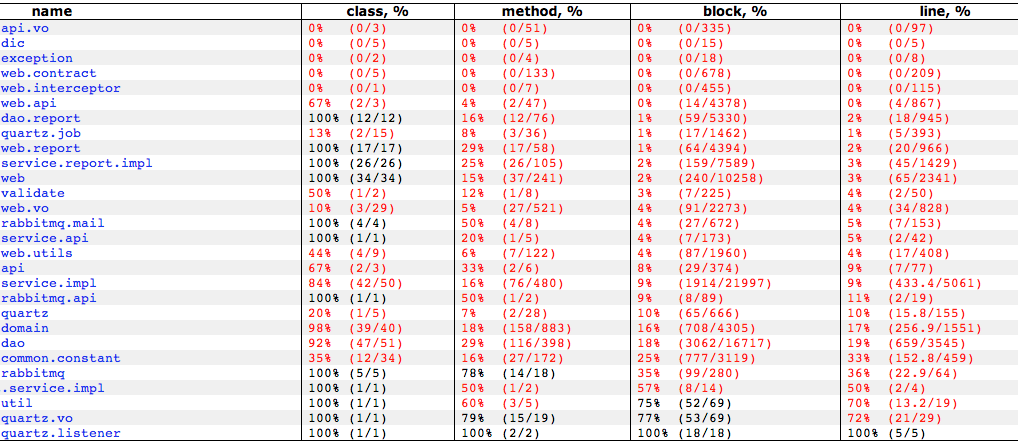
选中其中的java文件还可以查看具体的代码覆盖率
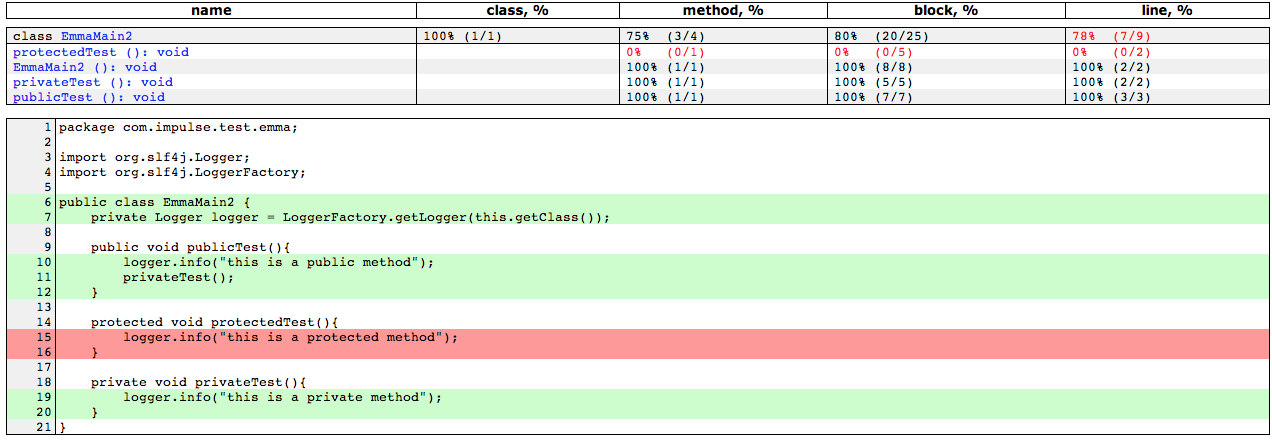
绿色为有测试的,红色的是测试未覆盖的。
Jenkins 测试查看:
在项目主页中查看
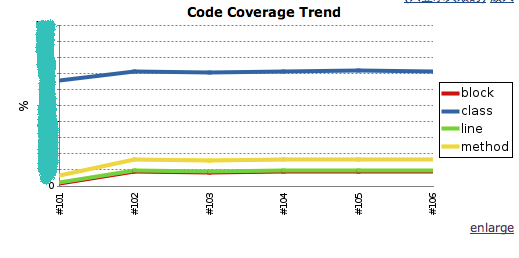
这里会有项目的测试覆盖率曲线。x轴是版本变化,y轴是测试覆盖率。
点进图片进入本版本的详细测试报告。具体的形式和本地测试报告差不多,只是 jenkins测试报告没有具体的代码测试详情。
工作原理
emma现在有两种工作方式,on-the-fly模式和offline模式:
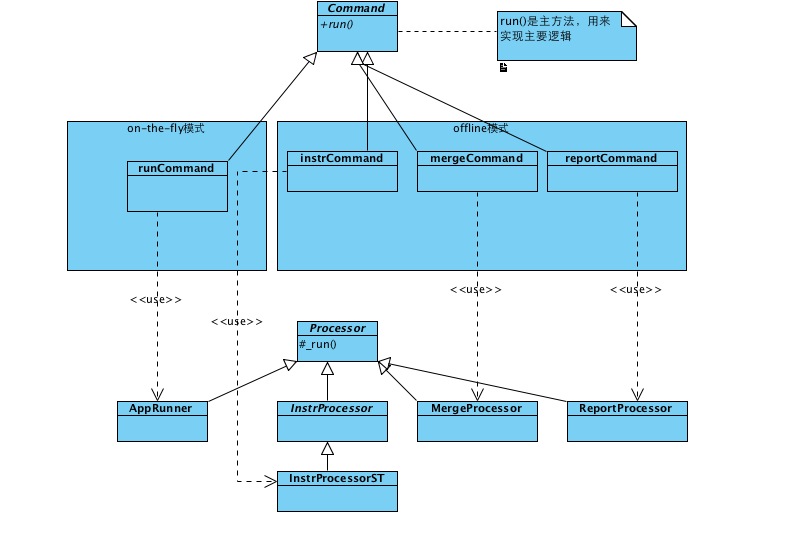
On the fly 模式往加载的类中加入字节码,在程序运行中,用 EMMA 实现的classLoader 替代应用默认的 Custom classLoader,动态加载类文件,并向类中加入一些统计测试的字节码,这样运行结束后,测试数据也就通过这些临时加入的字节码分析出来。
Offline 模式在类被加载前,在编译生成的class文件中加入字节码。
On the fly 模式比较方便,缺点也比较明显:
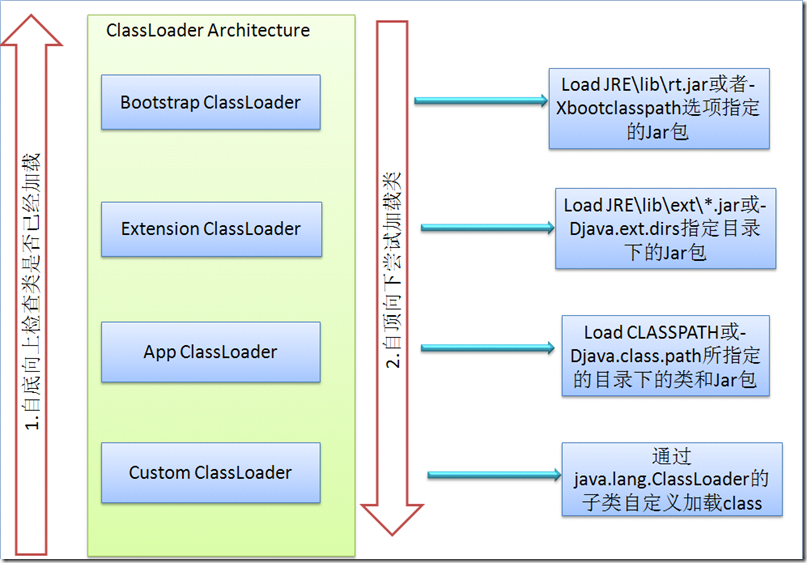
它不能为被 boot class loader 加载的类生成覆盖率报告;而且,J2EE的classLoader和EMMA的classLoader都是同一类Custom classLoader,在j2ee项目启动过程中,必须选择应用容器(tomcat、Weblogic等等)相应的classLoader,从而无法使用emma的classLoader。同时,jenkins必须配合mvn的框架才能运行emma相关命令,而mvn框架只支持offline模式,所以如果想使用jenkins来做测试报告的话,就无法使用on the fly模式。
在官方文档里也有说明:
As convenient as the on-the-fly mode is, in many cases it is not sufficient. For example, running a commercial J2EE container in a custom instrumenting classloader is practically impossible. Certain (bad) coding practices also fail for code executing in a custom classloader. This on-the-fly instrumentation mode is handy for light-weight testing of main() test methods, individual classes, and small- to- mid-size programs. emmarun also works well with Swing applications.
这时,我们只能求助于 Offline 模式。下面用maven的运行方式来介绍一下。
通过在maven中执行,我们可以看出emma工作时主要运行以下几个步骤
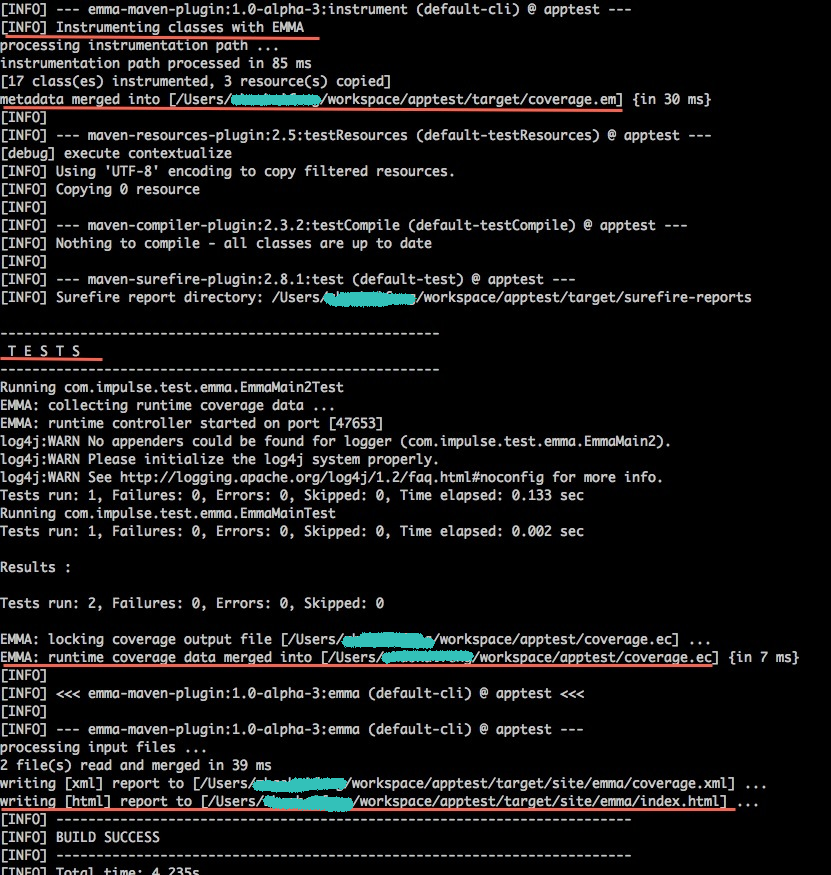
- 字节码插装并生成插装的元信息文件coverage.em
- 运行测试
- 每次当 JVM 停止时,内存中记录的执行信息将被清除并被保存到 “coverage.ec” 的文件中。
- 生成测试报告。
插装字节码
emma执行是最重要的就是插装字节码:

emma循环调用handleFile()方法来遍历目录下所有以’.class’结尾的文件,然后使用 classParser类得到要插装的组件
ClassDef class_table () throws IOException {m_table = new ClassDef ();magic ();version ();if (DEBUG) System.out.println (s_line);constant_pool ();if (DEBUG) System.out.println (s_line);access_flags ();this_class ();super_class ();if (DEBUG) System.out.println (s_line);//得到所有接口interfaces ();if (DEBUG) System.out.println (s_line);//得到所有字段fields ();if (DEBUG) System.out.println (s_line);//得到所有方法methods ();if (DEBUG) System.out.println (s_line);//得到所有attributeattributes ();if (DEBUG) System.out.println (s_line);return m_tabl e;
}
offline模式的插装会生成全新的class文件,默认放在target/generated-classes下。以下是原java文件和插装后的class反编译的java文件。
public class EmmaMain2 {private Logger logger = LoggerFactory.getLogger(this.getClass());//junit调用publicTest()进行测试public void publicTest(){logger.info("this is a public method");logger.info("我是分隔符------------------------------------------------------------------");for(int i =1 ;i<10;i++){privateTest();if(i==4){continue;}if(i==3){break;}//永远不会执行到这一步,所以protectedTest()并没有被覆盖if(i==5){protectedTest();return;}}}protected void protectedTest(){logger.info("this is a protected method");}private void privateTest(){logger.info("this is a private method");}
}
插装字节码之后反编译的代码
public class EmmaMain2
{private Logger logger = LoggerFactory.getLogger(getClass());private static final boolean[][] $VRc;private static final long serialVersionUID = -6204774612524021426L;public EmmaMain2(){arrayOfBoolean[0] = true;}public void publicTest(){boolean[][] tmp3_0 = $VRc; if (tmp3_0 == null) tmp3_0; boolean[] arrayOfBoolean = $VRi()[1]; this.logger.info("this is a public method");this.logger.info("我是分隔符------------------------------------------------------------------");int i = 1; arrayOfBoolean[0] = true;tmpTernaryOp = tmp3_0;do{privateTest();arrayOfBoolean[1] = true; if (i == 4) { arrayOfBoolean[2] = true;} else{arrayOfBoolean[3] = true; if (i == 3) { arrayOfBoolean[4] = true;break;}arrayOfBoolean[5] = true; if (i == 5) {protectedTest(); arrayOfBoolean[6] = true;return;}}i++; arrayOfBoolean[7] = true; arrayOfBoolean[8] = true; } while (i < 10);arrayOfBoolean[9] = true;}protected void protectedTest(){boolean[][] tmp3_0 = $VRc; if (tmp3_0 == null) tmp3_0; boolean[] arrayOfBoolean = $VRi()[2]; this.logger.info("this is a protected method");arrayOfBoolean[0] = true;}private void privateTest(){boolean[][] tmp3_0 = $VRc; if (tmp3_0 == null) tmp3_0; boolean[] arrayOfBoolean = $VRi()[3]; this.logger.info("this is a private method");arrayOfBoolean[0] = true;}static{boolean[] arrayOfBoolean = $VRi()[4];arrayOfBoolean[0] = true;}private static boolean[][] $VRi(){boolean[][] tmp9_6 = (EmmaMain2.$VRc = new boolean[5]);tmp9_6[0] = new boolean[1];boolean[][] tmp15_9 = tmp9_6;tmp15_9[1] = new boolean[10];boolean[][] tmp22_15 = tmp15_9;tmp22_15[2] = new boolean[1];boolean[][] tmp28_22 = tmp22_15;tmp28_22[3] = new boolean[1];boolean[][] tmp34_28 = tmp28_22;tmp34_28[4] = new boolean[1];boolean[][] tmp40_34 = tmp34_28;//将类信息加载到内存中。RT.r(tmp40_34, "com/impulse/test/emma/EmmaMain2", -5598510326399570528L);return tmp40_34;}
}
反编译有些问题,但我们可以看出,emma在每个方法的入口和出口和转移指令之前如return、break、continue都加入了监测代码,并在最后把代码的执行情况通过RT.r()方法加载到内存的m_coverageMap中。
public static void r (final boolean [][] coverage, final String classVMName, final long stamp){// note that we use class names, not the actual Class objects, as the keys here. This// is not the best possible solution because it is not capable of supporting// multiply (re)loaded classes within the same app, but the rest of the toolkit// isn't designed to support this anyway. Furthermore, this does not interfere// with class unloading.final ICoverageData cdata = getCoverageData (); // need to use accessor for JMM reasons// ['cdata' can be null if a previous call to dumpCoverageData() disabled data collection]if (cdata != null){synchronized (cdata.lock ()){// TODO: could something useful be communicated back to the class// by returning something here [e.g., unique class ID (solves the// issues of class name collisions and class reloading) or RT.class// (to prevent RT reloading)]cdata.addClass (coverage, classVMName, stamp);}}}public void addClass (final boolean [][] coverage, final String classVMName, final long stamp){m_coverageMap.put (classVMName, new DataHolder (coverage, stamp));}
所以当我们只测试publicTest()时,虽然publicTest()调用了protectedTest(),但由于我们通过条件语句的控制,使得protectedTest()永远不会被执行,因此在转移指令时加监控是必要的,我们可以在生成的报告中看出,
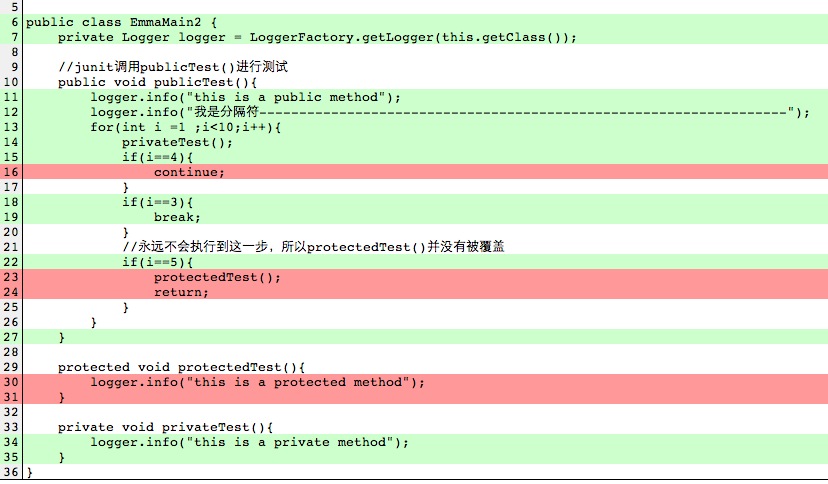
emma能够检测出那些虽然调用但没有执行到的代码。
收集覆盖率信息
emma会检测jvm的运行情况,当通过命令行调用reset或者虚拟机停止(一般是测试完成时),emma会将测试的覆盖率信息通过 dumpCoverageData()方法导出成实体文件。默认为coverage-*.ec文件。
static void dumpCoverageData (final ICoverageData cdata, final boolean useSnapshot,final File outFile, final boolean merge){try{if (cdata != null){// use method-scoped loggers everywhere in RT:final Logger log = Logger.getLogger ();final boolean info = log.atINFO ();final long start = info ? System.currentTimeMillis () : 0;{final ICoverageData cdataView = useSnapshot ? cdata.shallowCopy () : cdata;synchronized (Object.class) // fake a JVM-global critical section when multilply loaded RT's write to the same file{//在这里生者覆盖率信息文件,cdataView是CoverageData型,有一个重要的成员变量就是上面说的m_coverageMapDataFactory.persist (cdataView, outFile, merge);}}if (info){final long end = System.currentTimeMillis ();log.info ("runtime coverage data " + (merge ? "merged into" : "written to") + " [" + outFile.getAbsolutePath () + "] {in " + (end - start) + " ms}");}}}catch (Throwable t){// logt.printStackTrace ();// TODO: do better chaining in JRE 1.4+throw new RuntimeException (IAppConstants.APP_NAME + " failed to dump coverage data: " + t.toString ());}}
DataFactory.persist (cdataView, outFile, merge); cdataView是CoverageData型,有一个重要的成员变量就是上面说的m_coverageMap,没错,就是在这里把存在内存中的测试覆盖率信息持久化到文件中。
生成测试报告
AbstractReportGenerator是个抽象工厂,根据参数不同而产生不同的 ReportGenerator。
public static IReportGenerator create (final String type){if ((type == null) || (type.length () == 0))throw new IllegalArgumentException ("null/empty input: type");// TODO: proper pluggability pattern hereif ("html".equals (type))return new com.vladium.emma.report.html.ReportGenerator ();else if ("txt".equals (type))return new com.vladium.emma.report.txt.ReportGenerator ();else if ("xml".equals (type))return new com.vladium.emma.report.xml.ReportGenerator ();else // TODO: error codethrow new EMMARuntimeException ("no report generator class found for type [" + type + "]");}
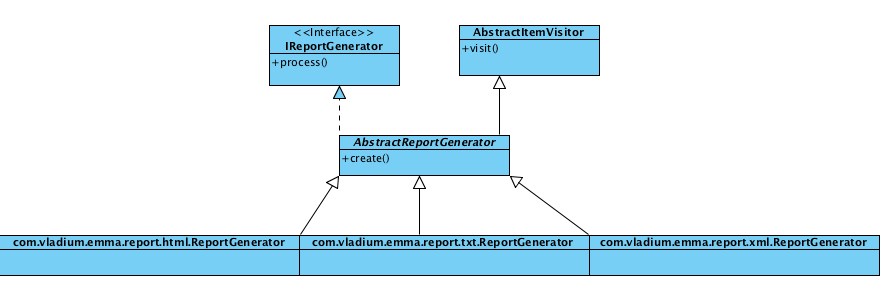
public
abstract class AbstractItemVisitor implements IItemVisitor
{// public: ................................................................//概要覆盖信息public Object visit (final AllItem item, final Object ctx){return ctx;}//包测试覆盖信息public Object visit (final PackageItem item, final Object ctx){return ctx;}//源文件测试覆盖信息public Object visit (final SrcFileItem item, final Object ctx){return ctx;}//在html中没有public Object visit (final ClassItem item, final Object ctx){return ctx;}//在html没有public Object visit (final MethodItem item, final Object ctx){return ctx;}
}
三种ReportGenerator都实现了IReportGenerator接口的process方法来到处报告,而process方法又分别调用了各种重载的visit()方法。当maven生成html测试报告是,只用了生成概要覆盖信息、源文件测试覆盖信息、包测试覆盖信息的方法。
参考资料
- emma官方网站
- 使用 EMMA 测量测试覆盖率
- 可爱的EMMA:测试覆盖率工具



)
)




)








)